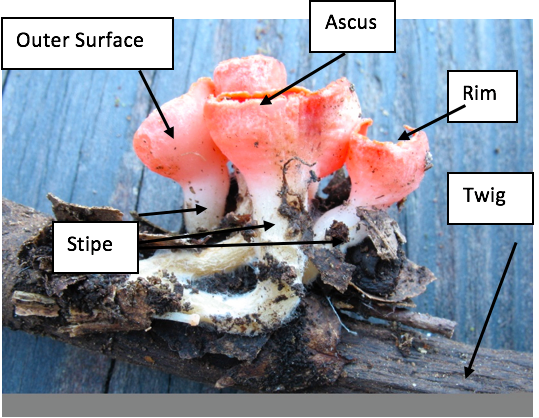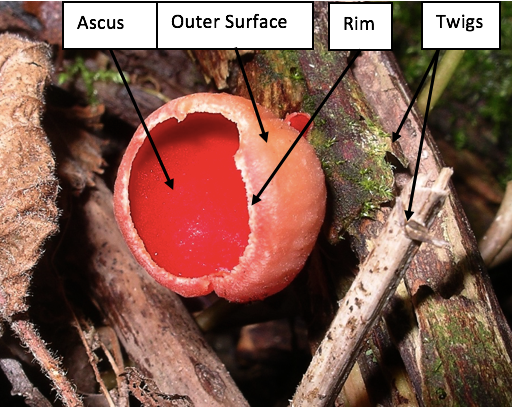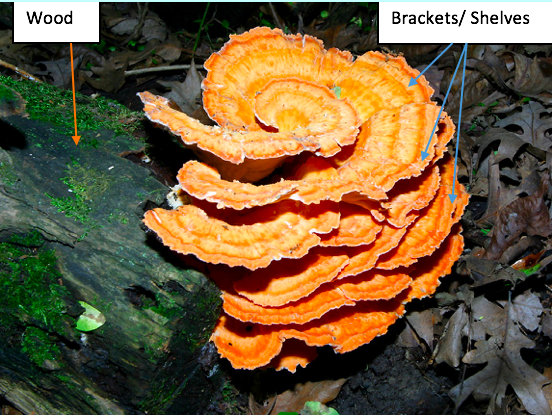DOMAIN • three
•Kingdom fungi•
Common name- Scarlet Elf Cup
Domain: Eukarya
Kingdom: Fungi
Division: Ascomycota
Class: Pezizomycetes
Order: Pezizales
Family: Sarcoscyphaceae
Genus: Sarcoscypha
Species: coccinea

Figure 6a: Sarcoscypha coccinea
In the picture above one can see a side view of this fungus and how the color of the outer, and inner surface differs, as well as the stalk color from the rest of the fungi.

Figure 7a: Top View of the Scarlet Elf Cup.
This photo was taken using a Pentax Optio555 digital camera. In the picture above one can see a top view of this fungus. One can also see the type of environment this fungus grows in and a clearer view of the different colors in the Scarlet Elf Cup.
The Scarlet Elf Cup is a eukaryotic, multicellular fungi found during the winter. It is found in the northern hemisphere by shady, damp areas filled with dead willow or elm trees, twigs and mossy areas. Their walls are made of chitin. They look like a small red cup with a white stipe, and the outside of the cup, known as the ascus, is covered with tiny uncoiled hairs that are invisible to the naked eye. The diameter of the ascus is around .5 cm, across the opening it is around 1.4-5 cm and the overall height of this fungi is around 5.5 cm. This fungus will form ascospores in their ascus, will reproduce through spores and mitosis, and has no nervous system [9a].
This fruit producing fungi reproduces asexually through its spores. It is also heterotrophic since it absorbs sun rays and uses them as it’s source of energy. Indians have used the Scarlet Elf Cup as a substance that promotes and helps maintain homeostasis. When the fungi died, the Indians would dry them out, grind it until they were a powder and then would apply it to their bodies. This would make it a beneficial fungus. One interesting thing about this fungus is that it will make a “puffing” sound by releasing asci and spore discharge in the form of a cloud [9a].
Why this belongs in this Domain:
This organism is multicellular, eukaryotic and is a type of mushroom which classifies it under the kingdom of Fungi. This kingdom includes many different types of eukaryotic, multicellular and unicellular organisms including mushrooms and molds. The division Ascomycota includes fungi with an ascus that produce ascospores. This is why the Scarlet Elf Cup is classified under this division. The class Pezizomycetes includes some of the fungi classified under the division Ascomycota which includes the Scarlet Elf Cup. Since this fungus grows on wood or soil it is classified under the order of Pezizales. This fungus is shaped like a cup and grows in tropical regions, therefore, it is under the family Sarcoscyphaceae. This fungus is also bright colored, placing it under the genus of Sarcoscypha. This fungus is under the species coccinea due to the fact that it grows during colder months of the year. This fungus is not in the domain Archaea because it is not a prokaryotic, single-celled organism. This fungus has a nucleus and cannot live in extreme environments, thus making it impossible for the Scarlet Elf Cup to be classified under domainArcheae. It also does not fixate carbon and is not motile making it impossible for it to be classified under domain Bacteria.
Common name- Chicken of the Woods
Domain: Fungi
Phylum: Basidiomycota
Class: Agaricomycetes
Order: Polyporales
Family: Polyporaceae
Genus: Laetiporus
Species: sulphureus

Figure 8a: Chicken of the Woods.
In the picture above one can see the mushroom called “Chicken of the Woods.” One can also see the bright orange-yellow color and that is grows on wood.
The Laetiporus sulphureus, also known as the Chicken of the Woods, is a multicellular, eukaryotic mushroom [11] that grows from spring through fall in hardwood forests in North America [10a]. They can grow on host trees like Pyrus, Salix, Fagus, Prunus, Populus, and Robinia. Since they grow on host trees, they are heterotrophic organisms. They will absorb the nutrients out of dead or near dead trees [10a]. They absorb nutrients from these trees by making a brown heart rot in the center of the tree. This will suck all the nutrients out of the inside of the tree. This mushroom reproduces asexually through spores contained in the basidia [11a]. It is non-motile and has no nervous system [10a]. Chicken of the Woods have no stipe, and have caps that are shaped like shelves with hyphae inside the "shelves". They range from 5-60 cm across and are 4 cm thick [11a]. Their spores are approximately 5.5-7 µ by 3.3-5 µ [11a].
Chicken of the Woods is an edible mushroom that tastes like chicken when cooked. It has a bright orange, sometimes yellow, color, and as it gets older its color will fade [10a]. It is textured like suede and is smooth with small wrinkles on the surface [11a].
Why this belongs in this Domain:
This organism is eukaryotic and is a mushroom, making it fall under domain Fungi. It falls under the phylum Basidiomycota because it has hyphae and it reproduces through spores. It also has basidia, thus placing it in the class Agariomycetes. Since it inhibits and consumes trees, it is in the order Polyporales. Chicken of the Woods is in the family Polyporaceae because it is a bracket fungus, meaning it has no stem. The genus Laetiporus includes mushrooms that are edible, are made up of individual shelves or brackets, are an orange to yellow color and grow in the spring and fall, this means that the mushroom Chicken of the Woods falls in this genus. This mushroom does not belong in the domain Bacteria because it is eukaryotic, has no peptidoglycan, and does not fixate nitrogen. It is not in the domain Archaea because it is not single-celled, prokaryotic, and does not reproduce through binary fission, fragmentation or budding.
DM